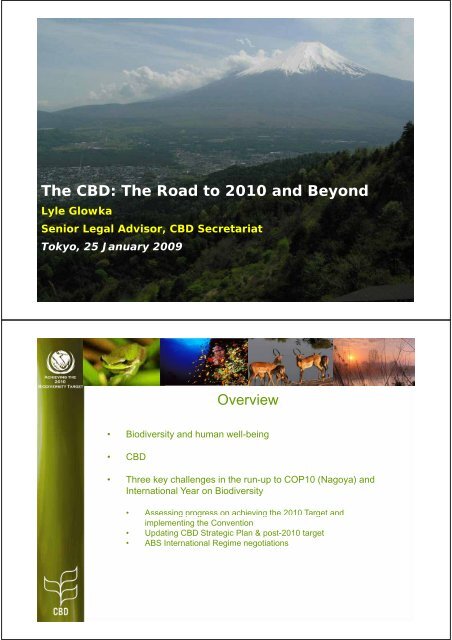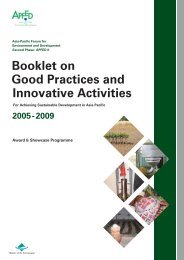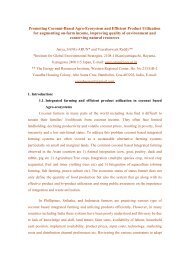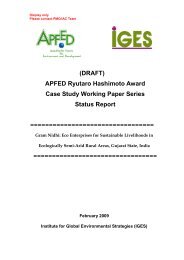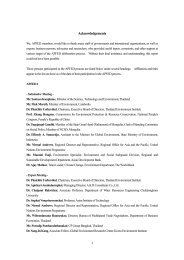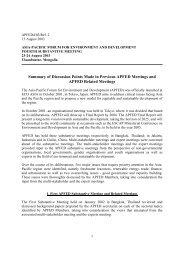The CBD: The Road to 2010 and Beyond Overview - APFED
The CBD: The Road to 2010 and Beyond Overview - APFED
The CBD: The Road to 2010 and Beyond Overview - APFED
- No tags were found...
You also want an ePaper? Increase the reach of your titles
YUMPU automatically turns print PDFs into web optimized ePapers that Google loves.
<strong>The</strong> <strong>CBD</strong>: <strong>The</strong> <strong>Road</strong> <strong>to</strong> <strong>2010</strong> <strong>and</strong> <strong>Beyond</strong>Lyle GlowkaSenior Legal Advisor, <strong>CBD</strong> SecretariatTokyo, 25 January 2009<strong>Overview</strong>• Biodiversity <strong>and</strong> human well-being• <strong>CBD</strong>• Three key challenges in the run-up up <strong>to</strong> COP10 (Nagoya) <strong>and</strong>International Year on Biodiversity• Assessing progress on achieving the <strong>2010</strong> Target <strong>and</strong>Assessing progress on achieving the <strong>2010</strong> Target <strong>and</strong>implementing the Convention• Updating <strong>CBD</strong> Strategic Plan & post-<strong>2010</strong> target• ABS International Regime negotiations
Biodiversity• Variety of life on Earth (<strong>and</strong> ecological complexes in which life exists)• Components of biodiversity: Genes, species (+ their populations) <strong>and</strong>ecosystems• Challenge: How <strong>to</strong> stem biodiversity loss <strong>to</strong> maintain its contributions<strong>to</strong> ecosystem structure <strong>and</strong> function <strong>and</strong> direct/indirect contributions<strong>to</strong> human well-being?Biodiversity underpins ecosystem functioning<strong>and</strong> the services that support human well-being
<strong>CBD</strong>: Basic Framework for Action• Comprehensive “biodiversity” focus: Conserving the “variety of life on earth”through conservation <strong>and</strong> sustainable use of its components (genes, species<strong>and</strong> ecosystems) <strong>and</strong> benefit sharing for genetic resources• Near universal membership: 191 parties (190 States <strong>and</strong> the EuropeanCommunity)• National level: Broad commitments for action by Governments• Biodiversity Strategy <strong>and</strong> Action Plans: Provide mechanism for Parties <strong>to</strong>organise their own approach (country-driven) <strong>to</strong> biodiversity loss (<strong>and</strong> fulfil <strong>CBD</strong><strong>and</strong> other biodiversity-related related international obligations) inter alia:• In situ conservation• Ex-situ conservation• Sustainable use (decision making)• Access <strong>to</strong> genetic resources <strong>and</strong> benefit sharing• Unifies international-level sec<strong>to</strong>ral approaches: Provides floor (or umbrella)<strong>to</strong> address all activities <strong>and</strong> processes that threaten biodiversity• Context for more specialised work of the 5 other sec<strong>to</strong>ral global l biodiversity-relatedi dagreements• Context for addressing climate change <strong>and</strong> desertification: Processes ultimatelythreaten biodiversity <strong>and</strong> human well-being<strong>CBD</strong> Framework for Action: Global “Toolkit”• Nine COPs: More than 200 policy-oriented decisions adopted as guidance <strong>to</strong> Parties <strong>and</strong>others• <strong>The</strong>matic work programmes (Seven major biomes): Forests, Dryl<strong>and</strong>s, Agricultural, Inl<strong>and</strong>Waters, Mountains, Marine/Coastal <strong>and</strong> Isl<strong>and</strong>s• Cross-cutting work programmes (17): Protected areas, climate change, taxonomy <strong>and</strong>technology transfer• Principles <strong>and</strong> guidelines: Complementary suite of guidance giving practical assistance <strong>to</strong>Parties on cross-cutting issues relevant <strong>to</strong> all thematic areas (eg): Sustainable use, invasivespecies, EIA <strong>and</strong> others• Ecosystem Approach: Strategy defined by 12 principles for integrated management of l<strong>and</strong>,water <strong>and</strong> living resources that promotes conservation <strong>and</strong> sustainable use in an equitableway.• Working groups assist implementation: PAs, Traditional Knowledge, Implementation <strong>and</strong>ABS• Biosafety Pro<strong>to</strong>col (2000): Ensures that living modified organisms do not adversely affectbiodiversity or human health• Synergies: Cooperation <strong>and</strong> collaboration with other international instruments, organisations<strong>and</strong> processes
Strategic Plan <strong>to</strong> <strong>2010</strong>• Strategic Plan (2002): Coherent focus on Convention’s work• Vision: To halt the loss of biodiversity• Mission: To achieve, by <strong>2010</strong>, significant reduction of current rate of biodiversityloss, through effective <strong>and</strong> coherent <strong>CBD</strong> implementation at all levels ascontribution <strong>to</strong> poverty alleviation <strong>and</strong> <strong>to</strong> benefit all life on earth (<strong>2010</strong> Target)• Four goals:• Goal 1: <strong>The</strong> Convention is fulfilling its leadership role in international biodiversityissues.• Goal 2: Parties have improved financial, human, scientific, technical, <strong>and</strong>technological capacity <strong>to</strong> implement the Convention.• Goal 3: National biodiversity strategies <strong>and</strong> action plans <strong>and</strong> the integration ofbiodiversity concerns in<strong>to</strong> relevant sec<strong>to</strong>rs serve as an effective framework for theimplementation of the objectives of the Convention.• Goal 4: <strong>The</strong>re is a better underst<strong>and</strong>ing of the importance of biodiversity <strong>and</strong> of theConvention, <strong>and</strong> this has led <strong>to</strong> broader engagement across society in implementation.• Eighteen objectives• Review <strong>and</strong> update: COP10 (<strong>2010</strong>)<strong>2010</strong> Target: Framework for Assessing <strong>and</strong>Communicating Global Progress• COP7: Established an assessment framework• Seven focal areas <strong>and</strong> associated “headline” indica<strong>to</strong>rs identified• FA1: Reducing rate of loss of components of biodiversity (e.g. (i) biomes, habitats <strong>and</strong>ecosystems; (ii) species <strong>and</strong> populations; <strong>and</strong> (iii) genetic diversity)• FA2: Maintaining ecosystem integrity/services from biodiversity for human well-being• FA3: Promoting sustainable use of biodiversity• FA4: Addressing major threats <strong>to</strong> biodiversity (e.g. invasive alien species, climatechange, pollution, <strong>and</strong> habitat change)• FA5: Protecting traditional knowledge, innovations <strong>and</strong> practices;• FA6: Ensuring the fair <strong>and</strong> equitable sharing of benefits arising i out of the use ofgenetic resources; <strong>and</strong>• FA7: Mobilizing financial <strong>and</strong> technical resources• Strategic Plan sub-targets, e.g.:• At least 10% of each of the world’s ecological regions effectively conserved• Status of threatened species improved• Biodiversity-based products derived from sources that are sustainably managed• Rate of loss <strong>and</strong> degradation of natural habitats decreased• Pathways for major potential alien invasive species controlled• Global Biodiversity Outlook: GBO2 (2006) <strong>and</strong> GBO3 (<strong>2010</strong>)
www.biodiv.org/gbo2www.maweb.orgGBO2: Most indica<strong>to</strong>rs show negative trends
Direct drivers are growing g in intensityMost direct drivers ofbiodiversity loss <strong>and</strong>degradation in ecosystemservices remain constant orare growing in intensity inmost ecosystemsProspects for achieving <strong>2010</strong> Target (MA)• Unprecedented additional efforts will be required <strong>to</strong> achieve, by <strong>2010</strong>, a significantreduction in the rate of biodiversity loss at all levels• Biodiversity is being lost at rates unprecedented in human his<strong>to</strong>ry <strong>and</strong> biodiversity willcontinue <strong>to</strong> decline this century (inertia <strong>and</strong> drivers)BUT:• Biodiversity losses <strong>and</strong> decline ecosystem services declines are a concern for human well being(especially for the poorest people)• <strong>The</strong> costs of biodiversity loss borne by society are rarely assessed, but evidence suggests that they areoften greater than the benefits gained through ecosystem changes• Drivers of loss of biodiversity <strong>and</strong> the drivers of change in eco¬system services are either steady, showno evidence of declining over time, or are increasing in intensity• Many successful response options have been used, but further progress in addressing biodiversity losswill require additional actions <strong>to</strong> address the main drivers of biodiversity loss• Appropriate response options at national level could result in reduction in the rate ofbiodiversity loss for certain components of biodiversity or indica<strong>to</strong>rs• Majority of targets established by Convention are achievable• <strong>The</strong> <strong>to</strong>ols needed <strong>to</strong> achieve <strong>2010</strong> target already in place
What’s needed? (GBO2)• Status of <strong>CBD</strong> Implementation: More national level action urgently needed• Mainstream biodiversity in<strong>to</strong> key sec<strong>to</strong>rs outside the traditional environmentalarea• Energy sec<strong>to</strong>r (role of biodiversity in mitigation <strong>and</strong> adaptation <strong>to</strong> climate change; roleof mitigation <strong>and</strong> adaption strategies t in biodiversity it loss)• Agricultural sec<strong>to</strong>r (largest driver l<strong>and</strong> use change)• Sustainable <strong>and</strong> efficient agriculture• L<strong>and</strong>scape level planning (ecosystem approach)• Sustainable consumption• End over exploitation of wild resources (eg, over-fishing <strong>and</strong> destructivepractices)• Protect <strong>and</strong> res<strong>to</strong>re critical ecosystems• Trade <strong>and</strong> economics (Liberalisation/subsidies, sustainability assessments of policies<strong>and</strong> role of perverse incentives at national level)• Development <strong>and</strong> poverty eradication• Re-invigoration of NBSAP roleUpdated Strategic Plan <strong>and</strong> post-<strong>2010</strong> target (COP Dec. IX/9)• Address three objectives of the Convention in a balanced manner• Build upon the existing Strategic Plan & framework of goals, targets & indica<strong>to</strong>rs• Be short, focused <strong>and</strong> action-oriented• Include ambitious but realistic, <strong>and</strong> measurable short term targets or miles<strong>to</strong>nes <strong>and</strong> a longterm target or vision, on the basis of robust scientific evidence• Provide a framework <strong>to</strong> establish national, <strong>and</strong>, where possible, quantitative, targets• Highlight the importance of biodiversity for the achievement of the MDGs• Address the drivers of biodiversity it loss <strong>and</strong> integrate t biodiversity it considerations in<strong>to</strong> relevantpolicies <strong>and</strong> planning processes• Draw upon, the framework <strong>and</strong> findings of the Millennium Ecosystem Assessment• Address challenges <strong>to</strong> implementation of the Convention• Address capacity building <strong>and</strong> resource mobilization• Provide for effective national moni<strong>to</strong>ring <strong>and</strong> reporting• Encourage universal membership of the Convention
Reconsideration of the Next Global ChallengeVision/Targets for:• 2020 ?• 2050 ?Types of target:• Quantitative ?• 2100 ? • National ?Objective:• Reduce loss• Halt loss• Res<strong>to</strong>re biodiversity <strong>and</strong>ecosystems• Prevent dangerous loss ofbiodiversity• Maintain biodiversity <strong>and</strong>ecosystem services forhuman well-being• No person suffers from theloss of biodiversityInternational Year of Biodiversity<strong>and</strong> COP-10 NagoyaAssess progress <strong>to</strong>wards <strong>2010</strong> biodiversity i targetUpdate <strong>CBD</strong> Strategic Plan & post <strong>2010</strong> targetCOP-10Negotiate <strong>and</strong> adopt ABS Int’l RegimeInternational Year of Biodiversity
2007: <strong>The</strong> Year ofClimate Change<strong>2010</strong>: <strong>The</strong> Year of Biodiversity
Thank You !


